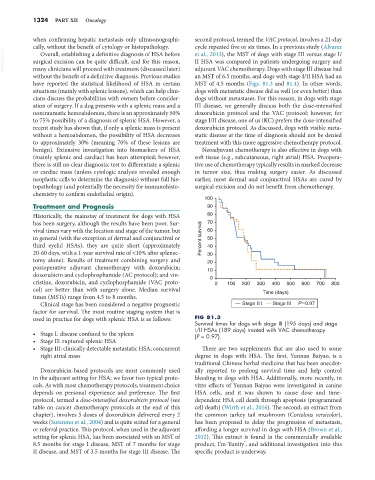Page 1352 - Small Animal Internal Medicine, 6th Edition
P. 1352
1324 PART XII Oncology
when confirming hepatic metastasis only ultrasonographi- second protocol, termed the VAC protocol, involves a 21-day
cally, without the benefit of cytology or histopathology. cycle repeated five or six times. In a previous study (Alvarez
VetBooks.ir surgical excision can be quite difficult, and for this reason, et al., 2013), the MST of dogs with stage III versus stage I/
Overall, establishing a definitive diagnosis of HSA before
II HSA was compared in patients undergoing surgery and
many clinicians will proceed with treatment (discussed later)
an MST of 6.5 months, and dogs with stage I/II HSA had an
without the benefit of a definitive diagnosis. Previous studies adjuvant VAC chemotherapy. Dogs with stage III disease had
have reported the statistical likelihood of HSA in certain MST of 4.5 months (Figs. 81.3 and 81.4). In other words,
situations (mainly with splenic lesions), which can help clini- dogs with metastatic disease did as well (or even better) than
cians discuss the probabilities with owners before consider- dogs without metastases. For this reason, in dogs with stage
ation of surgery. If a dog presents with a splenic mass and a III disease, we generally discuss both the dose-intensified
nontraumatic hemoabdomen, there is an approximately 50% doxorubicin protocol and the VAC protocol; however, for
to 75% possibility of a diagnosis of splenic HSA. However, a stage I/II disease, one of us (KC) prefers the dose-intensified
recent study has shown that, if only a splenic mass is present doxorubicin protocol. As discussed, dogs with visible meta-
without a hemoabdomen, the possibility of HSA decreases static disease at the time of diagnosis should not be denied
to approximately 30% (meaning 70% of these lesions are treatment with this more aggressive chemotherapy protocol.
benign). Extensive investigation into biomarkers of HSA Neoadjuvant chemotherapy is also effective in dogs with
(mainly splenic and cardiac) has been attempted; however, soft tissue (e.g., subcutaneous, right atrial) HSA. Preopera-
there is still no clear diagnostic test to differentiate a splenic tive use of chemotherapy typically results in marked decrease
or cardiac mass (unless cytologic analysis revealed enough in tumor size, thus making surgery easier. As discussed
neoplastic cells to determine the diagnosis) without full his- earlier, most dermal and conjunctival HSAs are cured by
topathology (and potentially the necessity for immunohisto- surgical excision and do not benefit from chemotherapy.
chemistry to confirm endothelial origin).
100
Treatment and Prognosis 90
Historically, the mainstay of treatment for dogs with HSA 80
has been surgery, although the results have been poor. Sur- 70
vival times vary with the location and stage of the tumor, but 60
in general (with the exception of dermal and conjunctival or Percent survival 50
third eyelid HSAs), they are quite short (approximately 40
20-60 days, with a 1-year survival rate of <10% after splenec- 30
tomy alone). Results of treatment combining surgery and 20
postoperative adjuvant chemotherapy with doxorubicin; 10
doxorubicin and cyclophosphamide (AC protocol); and vin- 0
cristine, doxorubicin, and cyclophosphamide (VAC proto- 0 100 200 300 400 500 600 700 800
col) are better than with surgery alone. Median survival Time (days)
times (MSTs) range from 4.5 to 8 months.
Clinical stage has been considered a negative prognostic Stage I/II Stage III P 0.97
factor for survival. The most routine staging system that is
used in practice for dogs with splenic HSA is as follows: FIG 81.3
Survival times for dogs with stage III (195 days) and stage
I/II HSAs (189 days) treated with VAC chemotherapy
• Stage I: disease confined to the spleen (P = 0.97).
• Stage II: ruptured splenic HSA
• Stage III: clinically detectable metastatic HSA; concurrent There are two supplements that are also used to some
right atrial mass degree in dogs with HSA. The first, Yunnan Baiyao, is a
traditional Chinese herbal medicine that has been anecdot-
Doxorubicin-based protocols are most commonly used ally reported to prolong survival time and help control
in the adjuvant setting for HSA; we favor two typical proto- bleeding in dogs with HSA. Additionally, more recently, in
cols. As with most chemotherapy protocols, treatment choice vitro effects of Yunnan Baiyao were investigated in canine
depends on personal experience and preference. The first HSA cells, and it was shown to cause dose and time-
protocol, termed a dose-intensified doxorubicin protocol (see dependent HSA cell death through apoptosis (programmed
table on cancer chemotherapy protocols at the end of this cell death) (Wirth et al., 2016). The second, an extract from
chapter), involves 5 doses of doxorubicin delivered every 2 the common turkey tail mushroom (Coriolous versicolor),
weeks (Sorenmo et al., 2004) and is quite suited for a general has been proposed to delay the progression of metastasis,
or referral practice. This protocol, when used in the adjuvant affording a longer survival in dogs with HSA (Brown et al.,
setting for splenic HSA, has been associated with an MST of 2012). This extract is found in the commercially available
®
8.5 months for stage I disease, MST of 7 months for stage product, I’m-Yunity , and additional investigation into this
II disease, and MST of 3.5 months for stage III disease. The specific product is underway.

